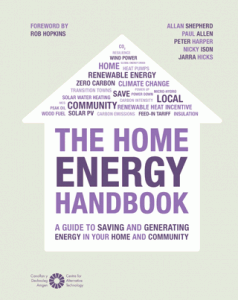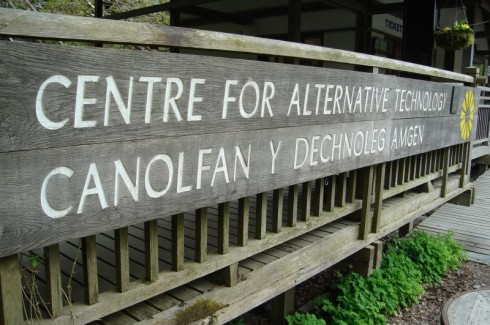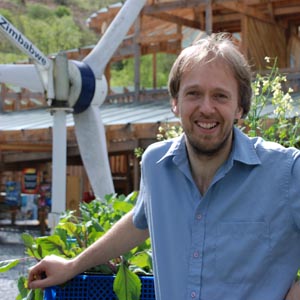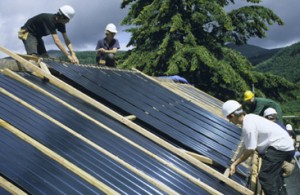2 Jul 2012
The Home Energy Handbook: an interview with Allan Shepherd

The Centre for Alternative Technology has just published a new book called ‘The Home Energy Handbook: a guide to saving and generating energy in your home and community’. It is a great resource for Transition groups, and Transition features strongly through the book. It is available here. I spoke to Allan Shepherd, one of the book’s authors/editors, and asked him to tell us more about the book. Here is the audio, transcript below:
Can you tell us where the idea for the book came from?
It started from the Zero Carbon Britain 2030 project really, because that was aimed at policy makers and government. What we wanted to do was take the concept that was developed in ZCB, which was the ‘Power down’ and the ‘Power up’ concept. So we needed to power down by 50% and then power up using renewables to reach this target of Zero Carbon Britain by 2030. We wanted to take that idea and then make it accessible to a general audience who could then take those concepts and put them into action at home and also in the community.
But we were really aware that it wasn’t enough to do stuff in your own home. It’s great to do that and really important to do that, but we all needed think about what we could do more at the community level because we can join resources together and make a lot more happen at the community level than just thinking about our own homes. We also wanted to give people a clear idea of where their energies were best used.
We also provided a chapter on carbon calculations and the global energy challenges of the 21st century so people would get a good idea of what the challenges were and where they could best reduce their carbon emissions and how they make their spend, if you like, most effective in doing that, and where they could put their energies in, which would create more results than other situations.
I think one of the things that distinguishes it from previous books is how it brings together that ‘things you can do’ and ‘things you can do as a community‘. Part of your research was looking at community renewables, the state of health of that sector in the UK. How would you categorise that? Where do you think we’re at in terms of community renewables in this country?
Well, we have a very good number of exemplar projects. We have a lot of projects that have existed for a few years that have set the game, if you like, places where they’ve installed a community wind turbine or community hydro and more recently, community solar. We have some very good examples where you can see what communities have actually done. Some have been working with bigger developers to own a percentage of a wind farm, for example, and then some are totally owned by the community. Some are raising money through share issues and stuff like that, to make things happen and some people are earning money from these projects and then diverting them into energy saving projects which is also a really exciting development, because we think that it’s great to earn money but if you’re then spending that on an activity that creates more carbon then you’re not really getting the benefit from it.
But there’s also a shortage of, well there’s some very good support actually out there from people like Plan LoCal which is part of the Centre for Sustainable Energy in Bristol and also obviously from the Transition Network and a lot of people are coming together through Transition initiatives to work out what their energy interests are. So there’s lots of support out there but there’s still, but it’s very small, the energy sector in Britain and it could be a lot bigger.
We know that there’s a great deal of interest, especially in some places like Bristol where there’s a lot of activity happening, several community groups almost vying with each other to get things happening. But there’s a lack of central government support for such projects at the moment, particularly the feed-in tariff level has created a lot of uncertainty.

Lots of projects started with the idea that they would get a set income from the feed-in tariff and just had the rug pulled from underneath them the cuts in feed-in tariffs coming half way through their projects. So there’s been uncertainty and that’s put a halt to some community development. Some people have asked for there to actually be a community-specific feed-in tariff break which would be set aside and different from the commercial operations and that makes a lot of sense because the government doesn’t want to penalise communities necessarily, they want to stop large scale projects and commercial enterprise taking up all the feed-in tariffs. I think that people would be very happy to pay a contribution through their energy bill if they saw that going back into their communities rather than necessarily into individual households or large scale commercial enterprises.
Clearly, the Zero Carbon Britain report sets out a very thorough, very detailed scenario of the amount of renewable energy that we need to get into place by 2030 in order to be a zero carbon Britain. Did you get a sense while you were researching this, of what percentage of that could potentially be owned by communities?
There is a limit. In a sense, most of the Zero Carbon Britain energy comes from large scale offshore windfarms and other centralised grid-linking projects, so we’re talking about supergrids linking countries perhaps even as far down as the Sahara and with their solar resource and other Mediterranean countries with the wind resource of the Northern countries because one of the issues with renewables is obviously variability and so to get rid of the variability issues then you need a big super-grid linking up places. I’m not sure what the overall potential would be. I think you had a figure actually when we talked before, I think you had a figure of how much that might be. How much communities could contribute.
Yes, we estimated (in ‘The Transition Companion’) it was about a quarter.
Right. I don’t know if there’s anything specific from Zero Carbon Britain and certainly not from the research I did, or a percentage figure. But certainly there’s an excess of money within communities that could be invested in community renewables rather than going out to commercial energy companies, and so there are some places where that can happen quite freely. I’d hesitate to say what the limit was but it’s clear that communities aren’t going to be able to do everything on their own.
So what do hope people will do with this work, once they get it in their hands? CAT is always about doing stuff. What things do you hope people will do as a result of reading it?
Well, I think what we wanted to do was create a culture of people changing their own energy practices at home and then extending that to a community level, actually meeting with friends to talk about how they might be able to take what they’ve learnt from the book and make that as a bigger scale. There’s plenty of inspiration in there to see how other people have done it, and then to meet and take that forward as groups.
To set up small groups rather than working on their own, because there’s always communities of interest within areas and it’s a question of mobilising people. There’s some very good information at the back of the book about how to set up a community energy project whether it’s energy conservation or energy generation and we hope people will read that and see the mechanisms for making that happen. But we don’t have a target for people to reach. That’s the general aim, to think about doing it at home first and then think about upscaling it.
One of the things that runs through the book … it’s great to see the profile that the book gives to Transition and that whole approach, and some of the responses moving through that. What struck you as the unique contribution that Transition brings to this? Why was that something that you felt should be reflected in the book?
Well the Transition groups take a holistic approach, I guess. It’s not just looking at energy issues but it’s looking at lots of different subjects and it’s giving people who don’t normally have access to change and opportunity to meet and discuss change without there being a negative issue. I think the thing that the Transition movement creates is a positive atmosphere for people to talk about change and a culture of thinking how that applies to a local situation. And also, it’s not just about one thing. It’s not just about energy, it’s about food, it’s about travel, it’s about work, it’s also about culture as well.
I think that’s the unique thing that Transition does. Whereas a lot of the other case studies were just looking at individual projects, individual energy projects, Transition culture is looking at a much bigger range of things and how those can be all tied together. I think that’s why it’s important for people to, yes, by all means think about just an energy project but then see how they might be able to link in with other things. Because what I’ve found with reading all the case studies, finding out about all the case studies, in this book, is that once people get together to do one thing, if it goes well, if it’s a success, if people work out a really good way of talking to each other and moving forwards, then they want to do other things.
They want to build on that one project and then go forwards because they see that community projects are actually a lot of fun and it’s a really good way of meeting neighbours and getting to know people and feeling part of something bigger than just yourself. I think isolation is actually a really big thing in modern society so to actually get over that through something like creating an energy project or food project is really important for people of all ages.
Thanks Allan. Any final things you’d like people to know about the book?
I’d say that it’s a very practical book. Its main focus is to give you the tools, as an individual, to do this at home or to get the correct advisor or engineer or person to help you with your project. It gives you knowledge at a very practical level which I think not many other books do, in this area. That’s the message really, it’s the practical element of it.


Paul Handover
2 Jul 5:31pm
Is it available in the US?
Allan Shepherd
3 Jul 9:42pm
Not yet directly, but we have been talking to Chelsea Green about US distribution, or you can buy it via http://www.amazon.com who presumably ship it out to the US from the UK. We also plan to make a ebook version too but I can’t tell you when that will be.
col
4 Jul 9:42am
Sounds great can you buy online?
Paul Handover
4 Jul 6:12pm
Thanks Allan, I’ll keep an eye open. Actually, could I ask a favour? That is, would you allow me to republish much of the above article on Learning from Dogs? Regards Paul.
Allan Shepherd
9 Jul 2:28pm
The interview? Yes that’s fine with me and I’m sure Rob won’t object. Allan
Allan Shepherd
9 Jul 2:29pm
You can buy the book online via http://www.cat.org.uk or in fact any online retailer. We don’t have an ebook version ready yet.
Paul Handover
9 Jul 3:20pm
Thanks Allan.